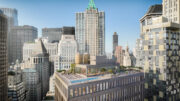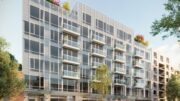Last year, we reported that New York City’s population had increased by 52,700 people between 2013 and 2014, hitting 8,491,079, and nearing what the city had previously projected for 2020. Today, the American Community Survey released updated data as of July 1, 2015, showing another large increase of 55,211, putting the five boroughs’ population at 8,550,405 – just 502 people short of the official 2020 projection.
The continued gains are unsurprising considering the general trends across much of the United States since the recession, which have been pushing numbers across most cities substantially higher. New York City also suffered from what many believe to have been an undercount as of the 2010 Census, which left additional room for numbers to catch up with reality.
The strongest borough in terms of numerical growth was Queens, which gained 16,700 people. Brooklyn was next, with a gain of 16,015, followed by the Bronx, with a gain of 13,687. The slowest growing boroughs were Manhattan and Staten Island, with changes of 7,552 and 1,257 individuals, respectively. Percentage-wise, the Bronx led the pack, with an increase of .95 percent year-over-year, beating out Queens’ .72 percent increase.
These changes show how the outer boroughs continue to consolidate gains, and if the permit activity in this year’s YIMBY report is any indicator, the trend should continue through the near future. While filings have now cooled off substantially in Manhattan and much of Brooklyn, momentum in areas where pricing has not reached obscene levels remains strong; The Bronx and Queens are densifying particularly quickly, and with construction activity continuing to increase in the Bronx and remaining strong in Queens, those two boroughs are likely to continue leading the city for the next few years.
While Manhattan has continued to see increases, its lack of buildable land has limited substantial growth. But this could also change in the coming years, as several neighborhoods are now experiencing major spikes in verticality, including the Financial District and Hudson Yards, where the city’s largest building by unit count (1,175) is set to open this year at 605 West 42nd Street.
The picture in Brooklyn is also positive, although mixed. While year over year filing activity has dropped significantly, population gains remain impressive, though accessibility issues may soon affect the growth of both Greenpoint and Williamsburg, which could face several years of subway disruptions. This may blunt momentum along the waterfront, but neighborhoods across inner Brooklyn should pick up the slack, and the accelerating boom in Downtown Brooklyn should also even out any pause along the East River.
Comparing the metro region with others across the country, New York has maintained its position as a leader for national growth, coming in with the fifth largest numerical increase of 87,988 people. Greater Los Angeles came in sixth with an increase of 85,671, while Chicagoland actually lost almost 3,000 people. Houston led the overall pack, adding 159,083 people, and Dallas came in second, adding 144,704 individuals. Atlanta and Phoenix came in third and fourth, with additions of 95,431 and 87,988 people, respectively.
While the sunbelt’s growth continues to be impressive, especially in percentage terms, the long-term trend of stronger growth in Los Angeles compared to New York has now seen a reversal. This is likely an indicator that a larger shift has occurred, and given 2015’s strong numbers, it may point to sustained gains for the entire New York region over the next several years.
Given the latest estimates are for July 1 of 2015, it is likely New York City is already several tens of thousands past the previous 2020 estimates. The year-over-year increase between 2014 and 2015 was up slightly over the previous increase (55,211 vs. 52,700) and likely portends a citywide population of approximately 8.8 million people or more by 2020.
The city’s growth is a sign that the region’s economic health is stable or improving, but this may not continue if infrastructure is unable to keep up with the demands of an increasing population. The MTA is no longer held accountable by anyone, with construction costs ballooning on all fronts and results failing to meet expectations. Even supposed successes, like the 7-Train extension to Hudson Yards, are already falling apart, and a $5+ billion proposal to revamp La Guardia ignores the fact that it’s about to be swallowed by the East River in the not-so-distant future, per the warnings of Dr. James Hansen, who correctly predicted that parts of the city would be underwater by the 2010s (and while many dismiss that as hyperbole, Sandy proved that rising tides need only be temporary, causing damage which the city is still recovering from).
The latest ACS numbers are certainly positive, but without reform to wasteful infrastructure spending that’s well beyond that of any other city on the planet, these gains may not continue for much longer. With the MTA outright refusing to divulge costs and Gov. Andrew Cuomo letting the agency run amok like a mad dog without a leash, New Yorkers must demand transparency and accountability from the agencies its citizens depend on, or the city’s growth – and its future as a whole – could soon be jeopardized.
Subscribe to YIMBY’s daily e-mail
Follow YIMBYgram for real-time photo updates
Like YIMBY on Facebook
Follow YIMBY’s Twitter for the latest in YIMBYnews






“the 7-Train extension to Hudson Yards, are already falling apart..”
What a shame, what a waste, ..
Keep in mind, however, that census estimates are notoriously inaccurate and are taken with a grain of salt by people in the business.
This is a good analysis.
Demographers, politicians, businessmen, and media always see massive population growth as a “good” thing but what good is it for the residents? Certainly not worsening traffic; longer lines at emergency waiting rooms, stores, restaurants, or attractions; or inevitable increases in people issues. Perhaps more Starbucks, Walgreens, and McDonalds locations? LOL, no real value add to current residents, besides these new places will quickly become just as crowded as other locations.
You would think as technology improves and our jobs allow for the ability to telecommute more easily these days, that people would be encouraged to gravitate to less crowded, sparsely populated locales to gain more space and serenity. But unfortunately the opposite is occurring – everyone is crowding in few places like NY, TX, FL, AZ making these places burst at the seams. This needs to be addressed on a national level to encourage people to stay put in declining or static areas. We need to spread out more bottom line and stay bringing in more foreigners when there are chronically unemployed, frustrated people who have nothing better to do than destroy others’ lives.
There are too many people to move to sparsely populated areas. In fact density is better because you use less resources per capita. Too much sprawl sucks up too many resources. Plus no matter what – humans are social creatures- and that is why they move where everyone else goes. Florida and Texas were sparsely populated only 60 years ago.
Terrible that with all this increase in hoards of tourists… 55 million from all over the USA and the increased numbers of people moving into the City, little is being done to upgrade the infrastructure, clean the streets and sidewalks, build more subways etc. There should be a subway going up the Hudson from 42nd with all the massive buildings going up. Imagine the increased traffic that’s going to generate.
YIMBY, thanks for the analysis. Build, build build and they will come. But the drive to build hasn’t stopped even upon saturation all resulting in not only scores of new buildings with tasteless and atrocious architecture non-compliant to current DCP building codes (like here in Flushing) but illegal immigrants. Those intent not on assimilation but separation and transformation by destroying the very homes and communities that so many native red-blooded New Yorkers have enjoyed for over a century.
The latest update of population in New York 2017 http://uspopulation2017.com/population-new-york-2017-2.html
2012 –8.34 Million
2013 –8.40 Million
2014 –8.49 Million
2015 –8.55 Million
2016 – 8.6 Million